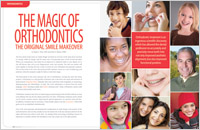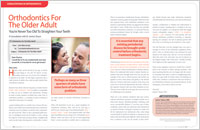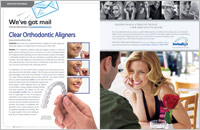Orthodontics for Kids
 For many teens, braces are a rite of passage: They're one more example of the changes adolescents go through at this time — along with growth in stature, edgier tastes in clothes and music, and an increasing degree of self-awareness. But is there any particular reason why orthodontic appliances and teenagers seem to go together? In a word: Yes.
For many teens, braces are a rite of passage: They're one more example of the changes adolescents go through at this time — along with growth in stature, edgier tastes in clothes and music, and an increasing degree of self-awareness. But is there any particular reason why orthodontic appliances and teenagers seem to go together? In a word: Yes.
There are several good reasons why adolescence is the optimal time for orthodontic treatment, though occasionally even earlier intervention is called for. One has to do with the development of the teeth: There's no set timetable for every kid, but generally by the age of 11-13 the deciduous (baby) teeth have all been lost, and the permanent ones have largely come in. This is the time when we can go to work correcting the problems that cause a bad bite (malocclusion), improper tooth spacing or poor alignment.
Orthodontic problems don't improve with age — they simply become harder to treat. It's easier to treat many orthodontic problems during adolescence because the body is still growing rapidly at this time. Whether standard braces are used, or appliances like palatal expanders , improved appearance and function can be created in a short period of time. In later years, when the bones of the face and jaw are fully developed, many conditions become more difficult (and costly) to treat.
There's even a social element to getting orthodontic treatment in adolescence. If you need braces, you're not alone! Chances are you'll see some of your classmates in the dental office, and you may even make new friends as you go through the process together. When it's done, you'll have a smile that you can really be proud of, and benefits that will last your whole life.
Types of Orthodontic Appliances
All orthodontic appliances work essentially the same way: by employing light, constant force to move teeth into proper alignment. But how we apply these forces can vary, as numerous innovations have become available in recent years. Some of the newer, less visible orthodontic appliances have been designed to blend more easily into an adult's personal and professional lifestyle. Types of orthodontic appliances include:
 Traditional Metal Braces
— This is probably what you think of when you picture someone wearing braces: small metal brackets bonded to the front of the teeth. A thin wire runs through the brackets and is attached on either end to metal bands that go around a back molar.
Traditional Metal Braces
— This is probably what you think of when you picture someone wearing braces: small metal brackets bonded to the front of the teeth. A thin wire runs through the brackets and is attached on either end to metal bands that go around a back molar.
 Clear Braces
— Instead of highly noticeable metal brackets, you can have clear ones made of ceramic, plastic or a combination of both. They are hardly visible, except for the thin wire running through, but they are more susceptible to breakage than metal braces.
Clear Braces
— Instead of highly noticeable metal brackets, you can have clear ones made of ceramic, plastic or a combination of both. They are hardly visible, except for the thin wire running through, but they are more susceptible to breakage than metal braces.
 Clear Aligners
— As an alternative to the fixed type of orthodontic appliances mentioned above, clear aligners are removable. They are actually a series of clear plastic “trays” that fit over your teeth exactly. Each tray is part of a series of trays that move your teeth a little bit at a time until they are in the proper position. Your trays are designed with the help of specialized computer software that generates a virtual model of your bite.
Clear Aligners
— As an alternative to the fixed type of orthodontic appliances mentioned above, clear aligners are removable. They are actually a series of clear plastic “trays” that fit over your teeth exactly. Each tray is part of a series of trays that move your teeth a little bit at a time until they are in the proper position. Your trays are designed with the help of specialized computer software that generates a virtual model of your bite.
 Lingual Braces
— These metal braces are bonded to the back of your teeth (tongue side) so that no one can see them. That is the plus side. On the minus side, they can be more difficult to get used to wearing, and are more expensive than traditional braces.
Lingual Braces
— These metal braces are bonded to the back of your teeth (tongue side) so that no one can see them. That is the plus side. On the minus side, they can be more difficult to get used to wearing, and are more expensive than traditional braces.
After Treatment
Wearing a retainer after orthodontic treatment is crucial, no matter which type of appliance you choose and what age you happen to be. Teeth that are not held in place by a retainer long enough for new supporting bone to develop around them can drift back to their original positions, and that's certainly not something you want to see happen. You will be instructed on how to retain your new, more beautiful smile so that it continues to make you look and feel great for years to come.
For more information on adult orthodontics in Worth, IL call All Smiles at (708) 448-0333 today! Also serving Palos Heights, Palos Park, Oak Lawn, and Chicago Ridge, IL.
Adult Orthodontics Related Articles

The Magic of Orthodontics Proper alignment of the teeth is basic to “Smile Design.” Their position dictates how they work together and affects the way you look and smile. Only orthodontic treatment can move teeth into the right position. Simply put, when things look right, they probably are right. Learn the basics of smile analysis and design and whether the magic of orthodontics will work for you... Read Article

Orthodontics for the Older Adult Healthy teeth can be moved at any age, so there's no such thing as “too old” for braces. In fact, nowadays about one out of every five orthodontic patients is an adult. Yet this figure represents only a small portion of adults who could actually benefit from orthodontic treatment... Read Article

Clear Orthodontic Aligners Orthodontic treatment using clear aligners consists of a series of aligners that you change about every two weeks over a course of treatment lasting six to eighteen months depending on how much movement is needed... Read Article